 The south wall of the Wilderness Exhibit Shelter talks about the results of the battle: The Fighting Ends in Stalemate.
The south wall of the Wilderness Exhibit Shelter talks about the results of the battle: The Fighting Ends in Stalemate.

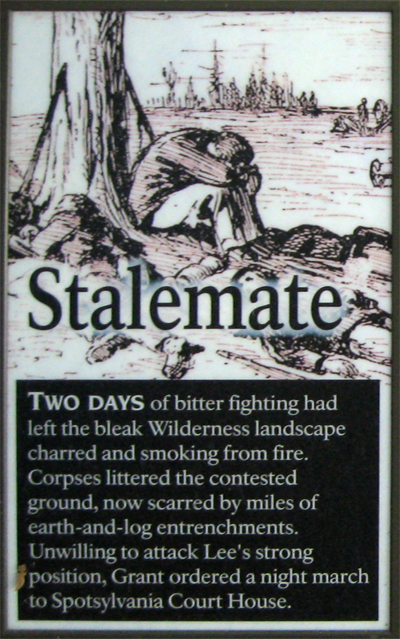
Stalemate
Two days of bitter fighting had left the bleak Wilderness landscape charred and smoking from fire. Corpses littered the contested ground, now scarred by miles of earth-and-log entrenchments. Unwilling to attack Lee’s strong position, Grant ordered a night march to Spotsylvania Court House.
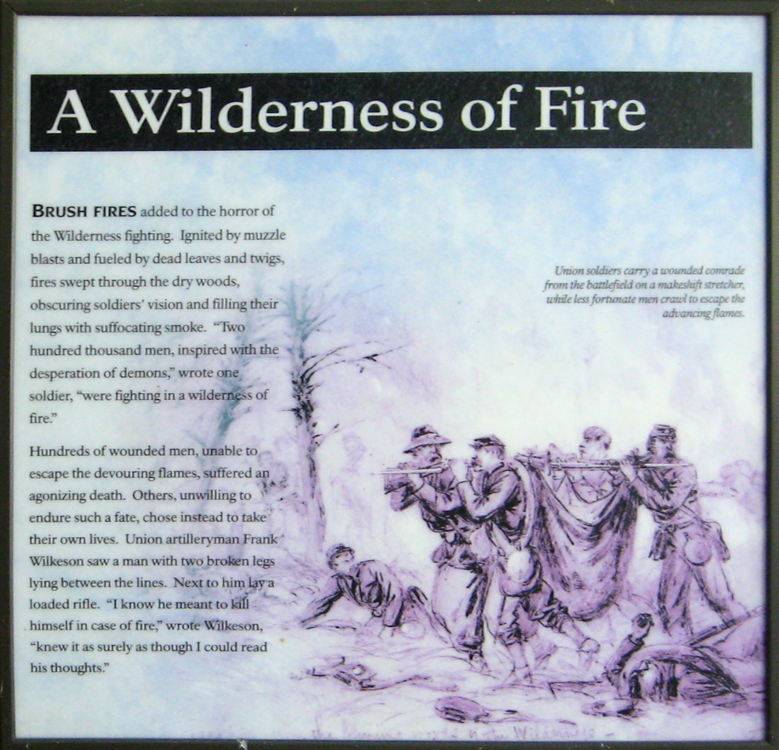
A Wilderness of Fire
Brush fires added to the horror of the Wilderness fighting. Ignited by muzzle blasts and fuled by dead leaves and twigs, fires swept through the dry woods, obscuring soldiers’ vision and filling their lungs with suffocating smoke. “Two hundred thousand men, inspired with the desperation of demons,” wrote one soldier, “were fighting in a wilderness of fire.”
Hundreds of wounded men, unable to escape the devouring flames, suffered an agonizing death. Others, unwilling to endure such a fire, chose instead to take their own lives. Union artilleryman Frank Wilkerson saw a man with two broken legs lying between the lines. Next to him lay a loaded rifle. “I know he meant to kill himself in case of fire,” wrote Wilkerson, “knew it as surely as though I could read his thoughts.”
From the caption to the drawing:
Union soldiers carry a wounded comrade from the battlefield on a makeshift stretcher, while less fortunate men crawl to escape the advancing flames.
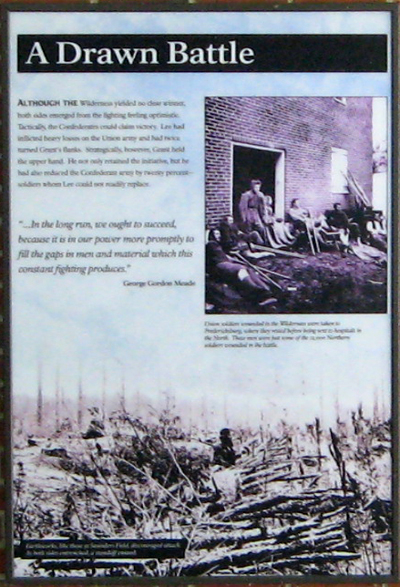
A Drawn Battle
Although the Wilderness yielded no clear winner, both sides emerged from the fighting feeling optimistic. Tactically, the Confederates could claim victory. Lee had inflicted heavy losses on the Union Army and had twice turned Grant’s flanks. Strategically, however, Grant held the upper hand. He had not only retained the initiative, but he had also reduced the Confederate army by twenty percent — soldiers that Lee could not readily replace.
“In the long run, we ought to succeed, because it is in our power more promptly to fill the gaps in men and material which this constant fighting produces.”
George Gordon Meade
Caption to the photo on the upper right:
Union soldiers wounded in the Wilderness were taken to Fredericksburg, where they rested before being sent to hospitals in the north. These men were just some of the 12,000 Northern soldiers wounded in the battle.
Caption to the background photo:
Earthworks, like these at Saunders Field, discouraged attack. As both sides entrenched, a standoff ensued.
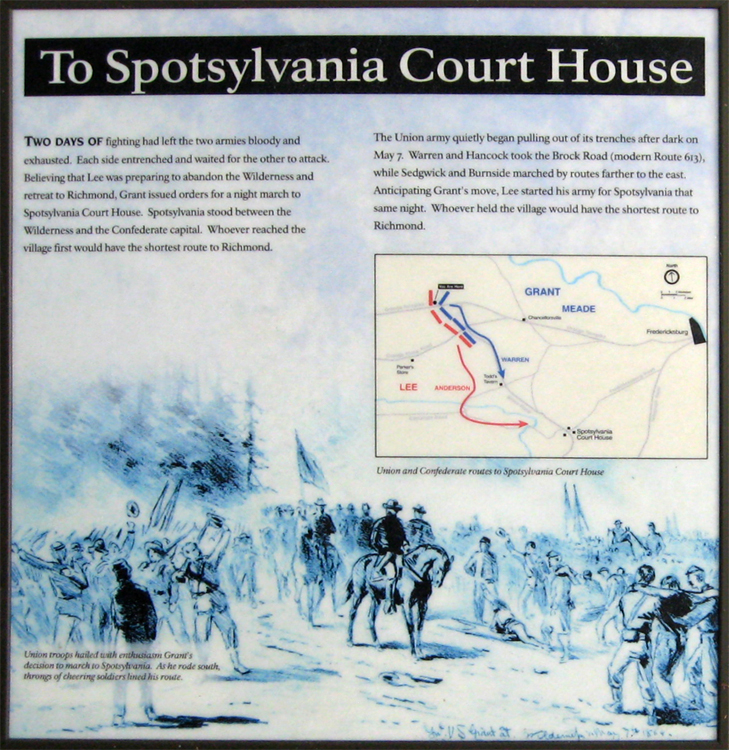
To Spotsylvania Court House
Two days of fighting had left the two armies bloody and exhausted. Each side entrenched and waited for the other to attack. Believing that Lee was preparing to abandon the Wilderness and retreat to Richmond, Grant issued orders for a night march to Spotsylvania Court House. Spotsylvania stood between the Wilderness and the Confederate capital. Whoever reached the village first would have the shortest route to Richmond.
The Union army quietly began pulling out of the trenches after dark on May 7. Warren and Hancock took the Brock Road (modern Route 613), while Sedgwick and Burnside marched by routes further to the east. Anticipating Grant’s move, Lee started his army for Spotsylvania that same night. Whoever held the village would have the shortest route to Richmond.
Text from the caption to the map:
Union and Confederate routes to Spotsylvania Court House
Text from the caption to the drawing:
Union troops hailed with enthusiasm Grant’s decision to march to Spotsylvania. As he road south, throngs of cheering soldiers lined his route. A map on the right shows Union and Confederate routes to Spotsylvania Court House.
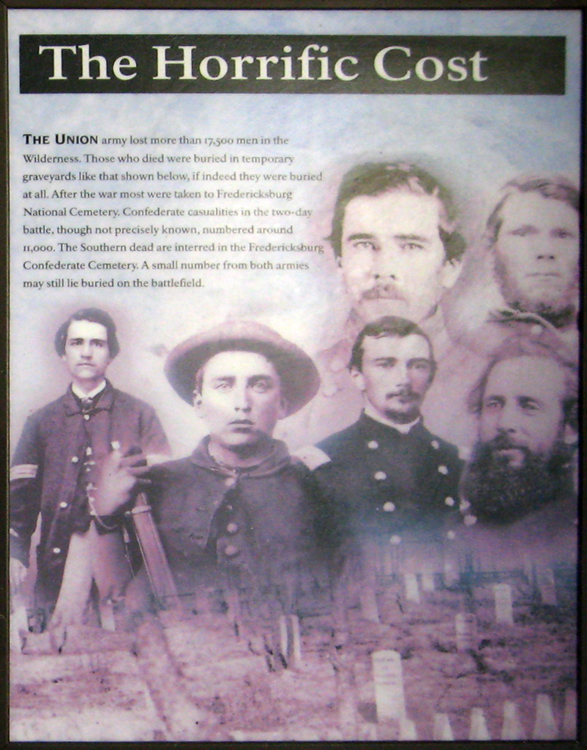
The Horrific Cost
The Union army lost more than 17,500 men in the Wilderness. Those who died were buried in temporary graveyards like that shown below, if indeed they were buried at all. After the war most were taken to Fredericksburg National Cemetery. Confederate casualties in the two-day battle, though not precisely known, numbered around 11,000. The Southern dead are interred in the Fredericksburg Confederate Cemetery. A small number from both armies may still lie buried on the battlefield.
The Battle of the Wilderness was the fourth most costly battle of the Civil War, following Gettysburg, Chickamauga and Spotsylvania. Chancellorsville, which overlaps the Wilderness battlefield to the east, was the fifth.
(return to the main Exhibit Shelter page)
(return to the Stop 2 page)
